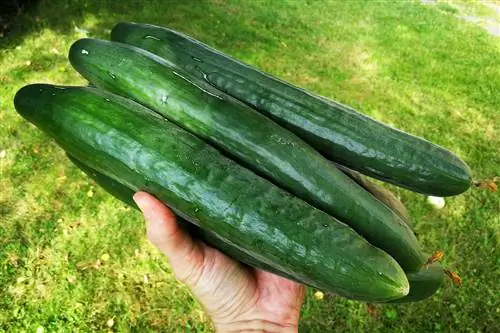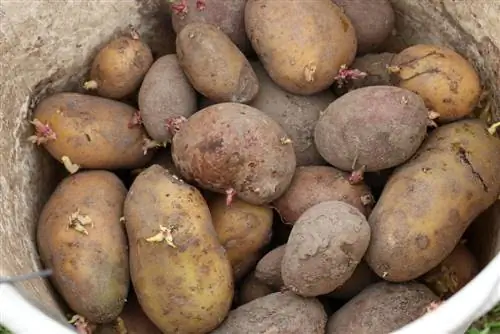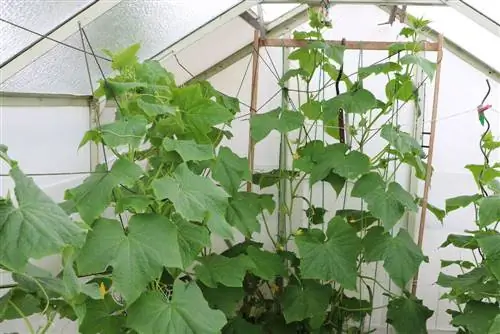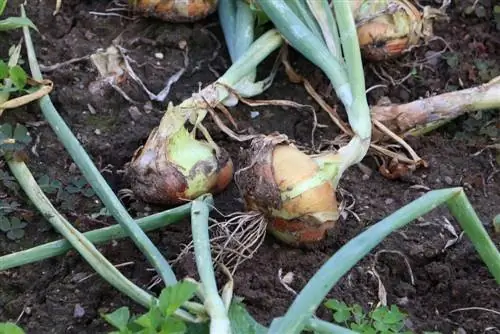- Author admin [email protected].
- Public 2023-12-17 03:39.
- Last modified 2025-01-24 12:45.
Cucumbers are a popular and refreshing summer vegetable that is particularly often grown in the home garden. But what should you take into account when harvesting outdoor cucumbers and cucumbers? We'll show you how to harvest cucumbers correctly.
Harvest cucumbers correctly
When the first green cucumbers can be spotted between the lush thickets of leaves, it's that time again and the harvest can begin. In the open field it happens around July and in the greenhouse from the end of May. Use this technique to harvest cucumbers correctly:
- always cut off the stem with a sharp knife or scissors
- alternatively twist off cucumbers
- don't tear it down under any circumstances
- Plant parts could tear off
- early morning ideal harvest time
- Nutrient content highest
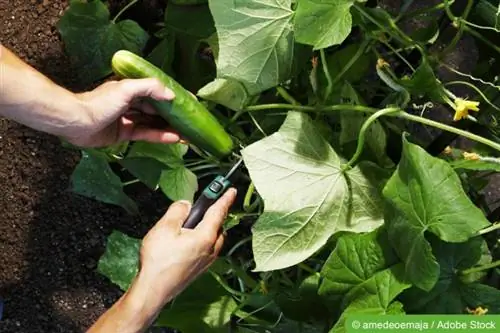
Tip:
It's best to check the plant for fruits every two to three days.
Harvest tips
You shouldn't wait too long when harvesting cucumbers. If harvested continuously, the plant quickly produces new fruits and the harvest period is extended.
- Do not leave fruits on the plant for too long
- the longer on the bush, the larger the fruits
- usually at the expense of quality
- It is best to harvest cucumbers before the seeds are ripe (medium-sized fruits)
- different cucumber sizes depending on the variety
- optimum size for outdoor cucumbers 10 to 15 cm
- for cucumbers 25 to 30 cm
- Gherkins between 5 and 12 cm
At the end of summer it is advisable to remove any remaining buds and flowers. This allows the plant to invest its energy in the remaining fruits so that they can still ripen.

Tip:
To support the cucumber in fruit formation - as it is a heavy eater it needs plenty of nutrients - you should treat it with diluted nettle manure (1:20) about every four weeks.
Store cucumbers correctly
The cucumber is not a classic storage vegetable because it only has a limited shelf life when fresh. This is due to their high water content of up to 95 percent. The time of harvest also plays an important role, because the later you harvest the cucumbers, the less long they can be stored. Storing freshly harvested fruit for a few days is no problem. It's best to use them up as quickly as possible or proceed accordingly:
- cool and dark rooms are optimal
- at temperatures between 10 and 13 degrees
- for example an unheated cellar or pantry
- Storage possible for two to three weeks
- Fridge too cold
- Kitchen too warm
When storing, cucumbers should not be placed near apples, pears or tomatoes. These vegetables release the ripening gas ethylene, which would cause the cucumbers to spoil even faster.
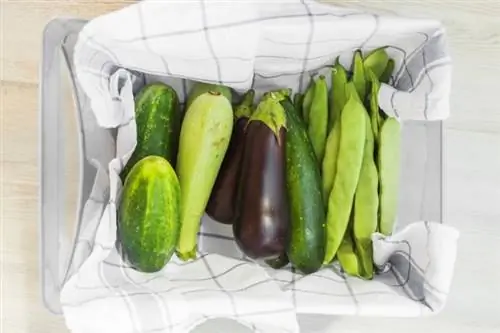
Tip:
If you have no other option and have to store the cucumbers in the refrigerator, you should not do so for longer than four days and only in the vegetable compartment. It's best to wrap them in a damp cloth and place them in a plastic or glass container with a lid.
Extend shelf life
The shelf life of cucumbers can only be extended if they are processed appropriately, i.e. pickled. If you only want to enjoy fresh fruit, the only options are the natural harvest times. These vegetables are only suitable for freezing if you want to use them later in cooked dishes. The effort involved in freezing and pickling is comparatively low.
Freeze for cooking
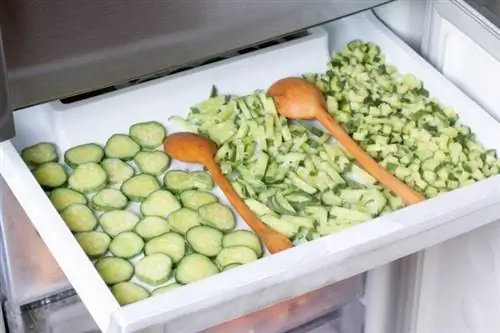
- First peel the cucumbers
- Halve and core the peeled fruits
- cut into thin slices
- fill into airtight freezer bags or plastic containers
- Close container tightly and place in freezer
- when using, add directly to boiling liquid
Note:
Even if freezing is possible, cucumbers do not last indefinitely when frozen and should be used within a year.
Freeze in dressing
- Peel cucumbers, cut into slices
- fill into suitable containers or freezer bags
- Mix dressing from vinegar, oil, s alt and spices as desired
- Pour the mixture over the cucumber slices
- seal well and freeze
Insert
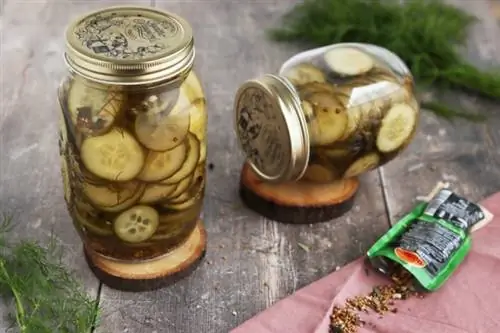
- Clean cucumbers, leave them whole or cut them into small pieces
- Clean preserving jars with hot water until green
- Put or layer cucumbers
- Make vinegar stock with spices according to your personal taste
- Bring the mixture to the boil and pour over the cucumbers
- Fruits should be covered
- Close jars immediately, place upside down, allow to cool
Tip:
There are countless spice variations for pickling cucumbers, depending on your personal taste.
Frequently asked questions
Can you harvest cucumbers too early?
You don't necessarily have to let cucumbers fully ripen; young fruits can also be eaten. They have a particularly delicate taste, are crunchy and contain hardly any annoying seeds. There are practically no unripe fruits in cucumbers. If green cucumbers turn yellow, they are overripe but can still be eaten. However, the flesh is no longer as crunchy and the peel is hard.
When are cucumbers ripe?
Ripe cucumbers can be recognized primarily by their fresh, pleasant smell and a uniform dark green color, provided they are a green and not a yellow variety. They have a firm consistency and a plump, taut shell. An exception is the peeled cucumber, where the beginning of yellowing signals the ripeness of the fruit and the right time to harvest. This variety has a particularly thin skin and is often used for pickling cucumbers.
What happens if cucumbers stay on the plant too long?
The cucumbers become watery, form bitter substances and weaken other fruits. This is particularly evident in the fact that they are often rejected in the early stages. But this can also have other reasons, such as a lack of water.

